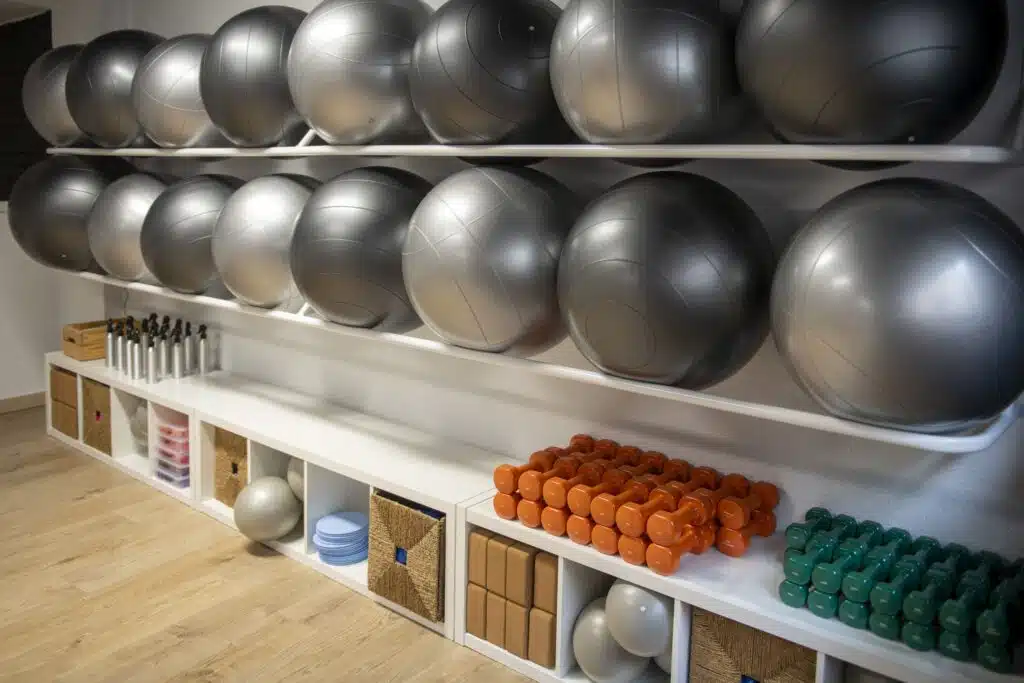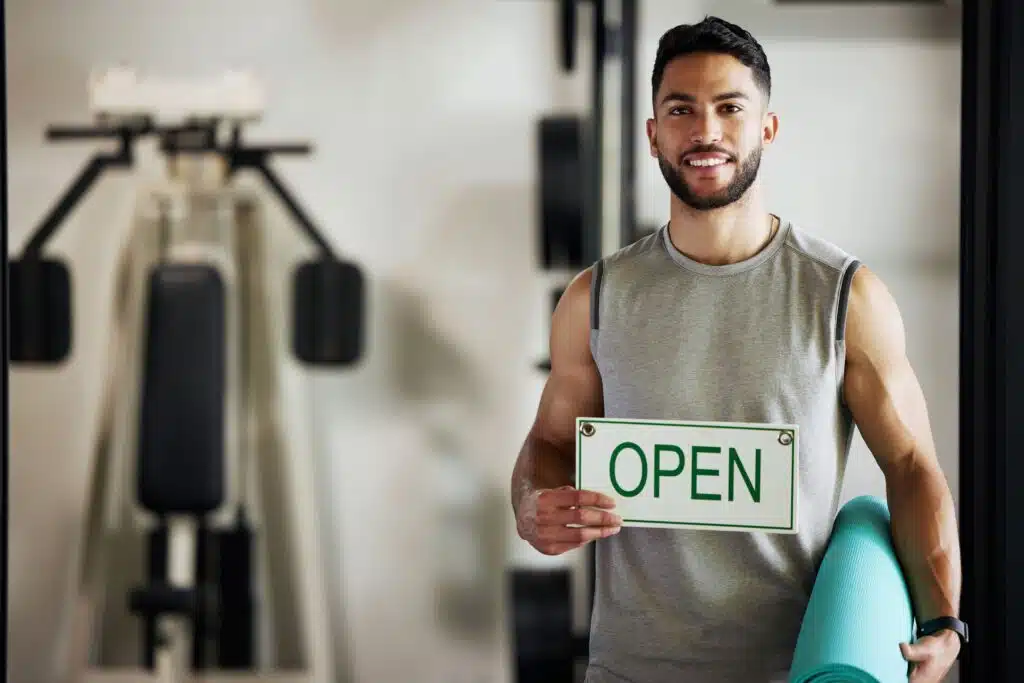8 Fitness Business Ideas for Every Budget: From $500 to $500K
Look, I know what you’re thinking. “I want to start a fitness business, but I don’t have a trust fund.” Join the club.
Here’s what nobody tells you when you’re googling “how to start a fitness business” at 2 AM: you don’t need a fortune to make this happen. The fitness world has blown wide open over the last years! You no longer need 10,000 square feet and a parking lot to actually build something real.
Whether you’re sitting on $500 or $500K, whether you’re figuring out how to build a fitness business from your garage or how to grow your fitness business into something bigger, trust me when i tell you: there’s a path for you.
Let’s dive in some fitness business ideas you can start today! Whether your budget is small or large, there’s something here for you!
1. Online Personal Training Business ($500-$1,500)
Here’s the beautiful part: you probably already own everything you need. To be sure, please respond to these questions: Got a laptop? A phone with a decent camera? If the answer was yes for either or both, you’re basically ready to launch.
Your shopping list:
- Whatever device you’re reading this on
- Zoom or Google Meet for video
- Calendly for scheduling (free version works)
- Stripe or PayPal to get paid
The money math: You can charge $40-75 per hour for virtual sessions. With 10-15 regular clients, you could be making $4K-8K each month. And the best part? Your overhead is just whatever you’re already paying for internet!
The move: You don’t want to be “just another online trainer.” Find your special focus! Maybe it’s postpartum fitness, or strength training for people over 50, or mobility work for those of us stuck at desks all day. That specificity? That’s what helps you build a fitness business that really stands out.

2. Park Boot Camp Classes ($300-$800)
The most stripped-down version. Find a park. Buy some bands and cones, and just… Show up!
What you’re spending:
- Liability insurance: $200-400/year (not optional)
- Equipment: $200-300 (bands, jump ropes, cones, agility ladder)
- Bluetooth speaker: $50-100
- Business cards: $50
The revenue: You can charge around $15-20 per drop-in, or offer monthly unlimited passes for $100-150. Imagine having 15 people show up to three classes each week! that works out to about $6,750 a month! And here’s the best part: you’re working outside, with no rent or electric bills to worry about.
Growth path: Why not start with a 6 AM class and invite anyone you know who might be interested? Share helpful tips and updates in local Facebook groups. just make sure to focus on being genuinely helpful rather than pushy. You’ll probably be amazed at how much interest you get within six months! When that happens, you can add more sessions and even bring on some help. That’s a really natural way to grow your fitness business!
3. Home Studio Personal Training ($3,000-$8,000)
Got a garage storing stuff you don’t use? A basement that’s “eventually” going to be something? That’s a business waiting to happen, and it could be your home personal training studio!
Investment breakdown:
- Equipment (dumbbells, kettlebells, TRX, bench, mats): $2,000-3,500
- Mirrors: $200-400
- Rubber flooring: $500-1,000
- Sound system: $150-300
- Climate control: $500-2,000
- Insurance and licensing: $500-800
Why this works: Private training is a great option at $75-150 per hour! If you book 20 sessions weekly, you could be looking at $6K-12K monthly. Plus, there’s no landlord and no rent check to worry about. This gym business model can be really profitable if you’re great at training people.

4. Specialized Group Classes ($5,000-$10,000)
Rent someone else’s space when they’re not using it. it could be the church basement, or a community center… even another gym’s off-hours! The most important thing is to Focus on one thing and be the best at it.
Example: Spin classes
- 10 used spin bikes: $3,000-5,000
- Monthly space rental: $500-1,000
- Sound system: $400-700
- Insurance: $600-1,000
- Marketing: $500-1,000
Revenue model: If you run 5-6 classes each week and charge around $20 for drop-ins or $150 for monthly unlimited passes, you could be looking at about $4,500-6,000 monthly from drop-ins alone! And that’s before counting your monthly memberships, which can really add up nicely.
5. Boutique Fitness Studio ($15,000-$45,000)
An actual lease with your name on it. Your own door. Your own space. Let’s imagine what this looks like: a focused 1,200 square foot HIIT studio that’s completely yours!! how exciting is it?
Money needed:
- Rent deposits: $4,000-8,000
- Basic buildout: $5,000-10,000
- Equipment: $8,000-15,000
- Signage: $1,500-3,000
- Marketing: $1,000-2,000
- Legal stuff: $1,500-3,000
- Operating capital (3 months): $5,000-10,000
Business model: Unlimited memberships at $150-200 work really well here! You’ll want to aim for about 80-100 members to cover your costs and pay yourself. It’s also nice to offer class packs at $25-30 for people who aren’t quite ready to commit to a membership yet.
Real timeline: I’ll be honest with you, year one can be really challenging. You’ll probably be teaching every class, cleaning bathrooms, doing books at midnight. You might break even. Year two? Hire help and start see an actual profit. Remember why you did this. Year three? Some open second locations. Others stay put. Both paths are totally valid!

6. Specialized Training Facility ($20,000-$50,000)
Be specific. Olympic weightlifting. Brazilian Jiu-Jitsu. Baseball performance. So specific people will drive 30 minutes instead of going to the generic gym five minutes away.
Olympic weightlifting example:
- Lease and deposits: $6,000-10,000
- Olympic platforms (6-8): $5,000-8,000
- Barbells and plates: $8,000-12,000
- Racks: $4,000-6,000
- Flooring: $3,000-5,000
- Everything else: $4,000-9,000
Why this works: You only need 50-75 people paying $150-200 monthly. These people stick around forever because they feel part of something! Community in specialized facilities is insane.
7. Premium Boutique Studio ($70,000-$150,000)
Picture this: upscale environments with amazing vibes! We’re talking about spin studios, Pilates with reformers, and yoga classes that feel luxurious. These spaces work best in areas where people are happy to invest in their wellness and have the budget to do so.
Investment:
- Prime location deposit: $15K-30K
- Specialized equipment: $30K-60K
- Premium buildout: $30K-50K
- Everything else: $10K-25K
The exciting part: You can charge around $30-40 per class, which is great! For unlimited monthly memberships, you’re looking at about $250-350. Once you build up to 400-500 active members, you could be generating an amazing $80K-120K monthly! These studios really thrive in communities where fitness is more than just exercise, it’s a valued part of people’s lifestyle and self-care routine.

8. Full-Service Fitness Club ($200,000-$400,000)
This is the complete package! We’re talking about 8,000-12,000 sq ft with everything your members could want: cardio equipment, strength training, functional fitness areas, group fitness classes, nice locker rooms, and even childcare if you’d like! It’s basically what most people dream about when they think “I’m opening a gym.”
Investment:
- Real estate: $50K-100K
- Buildout: $75K-150K
- Equipment: $60K-100K
- Technology: $10K-20K
- Staff: $10K-20K
- Marketing: $10K-25K
- Operating capital: $30K-60K
Success metrics: You’ll want to aim for about 500-800 members paying around $60-100 each month. The exciting part is you could reach $500K-1M+ annually! Just keep in mind it typically takes about 2-3 years to get there. This is definitely a long-term journey, but you’ll be building something really meaningful and substantial!
Your Action Plan: How to Start a Fitness Business
1. Validate right now. Can you get 10 people to pay you this month? Not “would they if…” but actual payment. If you can’t with zero overhead, what makes you think a lease will fix it? This is how to start a fitness business successfully.
2. Get specific. “People who want fitness” isn’t specific. “Women over 40 who want to lift but feel weird in regular gyms” is specific. Knowing exactly who you serve is essential to build a fitness business that works.
3. Start minimum. You can always add more. You can’t un-sign a five-year lease. Test cheap. Learn fast. Scale when proven.
4. Steal knowledge. Find gym owners in non-competing cities. Buy them coffee. Ask what they’d do differently. Save thousands in mistakes.
5. Build audience first. Start posting helpful content now. Build email list. When you open, have people asking when they can join.
6. Know your numbers. How many members at what price to break even? To pay yourself? To profit? If you don’t know precisely, you’re not ready.

The Truth
The fitness industry is thriving and full of opportunity! There’s plenty of room for new voices, and it’s definitely not too late to jump in. People are actively looking for help with their health and wellness, and they’re happy to invest in it.
But they don’t need another generic gym. They need YOUR version. The specific thing you’re uniquely positioned to offer. The niche you understand because you’ve lived it.
Your job isn’t serving everyone. It’s serving your specific people exceptionally well. Pick the model fitting your budget, matching your experience, serving people you genuinely want to help.
Stop reading threads about whether this is viable. Stop watching videos about gym business ideas… You’ve got the information. You understand investment levels. You know the paths forward!
The only question: are you going to build this or keep thinking about it?
Your future gym business is waiting. Go get it.
